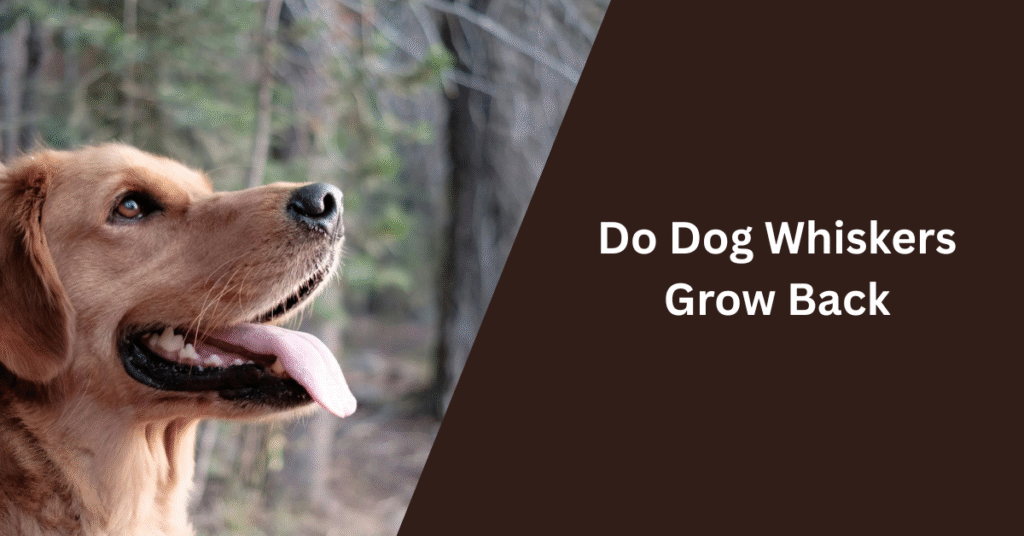Dog whiskers grow back after being lost or trimmed. Whiskers are specialized hairs with deep roots and strong blood supply, so they naturally regrow in several weeks. Growth speed depends on the dog’s age, breed, and health. While they do regrow, whiskers are vital for navigation and should not be intentionally cut.
Do Dog Whiskers Grow Back?
Dog whiskers can regrow after they are lost, but the process depends on several key factors. These include the individual dog’s health, the reason for whisker loss, and how whiskers differ from regular fur. Understanding these details helps owners set proper expectations.
Typical Regrowth Timeline
Whiskers usually begin to regrow within a few weeks after being damaged or lost. The full regrowth period can take between 1 to 3 months. This timeline varies by dog breed and age, as younger dogs often heal and regenerate faster.
If the whisker follicles are healthy and intact, regrowth is more likely. However, if the follicles were permanently damaged, whiskers might not come back. Owners should avoid trimming or pulling whiskers to prevent prolonged regrowth.
Factors That Influence Regrowth
Several factors affect whether and how quickly whiskers grow back. Nutrition plays a significant role; a balanced diet rich in proteins supports hair follicle health. Illness or stress can slow or halt regrowth.
Injuries or infections at the follicle site may prevent regeneration. Additionally, some dogs may experience permanent loss due to genetics or medical conditions. Environmental factors like exposure to harsh chemicals can also damage whisker follicles.
Differences From Other Types of Fur
Whiskers differ from regular fur in structure and function. They are thicker, stiffer, and embedded deeper in the skin with more nerve endings. This makes whiskers essential sensory tools.
Because whisker follicles are specialized, their regrowth rate and pattern differ from typical fur. Unlike shedding fur, whiskers do not follow the same growth cycles and generally fall out only when damaged or replaced naturally. This means whiskers are less likely to shed like normal hair but can take longer to regrow when lost.
The Function of Dog Whiskers
Dog whiskers serve specific biological roles that help them interact with their surroundings and with other dogs. These stiff hairs provide important sensory input and convey subtle emotional signals.
Sensory Role in Navigation
Dog whiskers, or vibrissae, are highly sensitive tactile hairs located around the muzzle, above the eyes, and on the chin. They detect slight changes in air currents and vibrations, enabling dogs to sense nearby objects without direct contact.
These whiskers help dogs navigate in low-light environments or tight spaces by alerting them to obstacles. Each whisker is connected to nerve endings, providing detailed information about the environment’s texture and proximity.
This sensory input helps dogs judge the size, shape, and speed of objects close to their face, improving spatial awareness and avoiding collisions, especially when visibility is limited.
Communication and Expression
Whiskers also play a role in conveying a dog’s emotional state. Changes in whisker position or movement can signal feelings such as curiosity, alertness, or aggression.
Dogs may flare their whiskers forward when excited or cautious and pull them back when relaxed or submissive. Observing whisker positioning can give insight into a dog’s mood.
Along with body language and vocalizations, whiskers form part of the complex system dogs use to interact socially with other dogs and humans. This subtle form of nonverbal communication helps reduce misunderstandings in social situations.
What Happens When Dog Whiskers Are Cut or Lost?
Cutting or losing a dog’s whiskers affects their sensory perception and behavior immediately. It also influences their comfort and interaction with their environment over time.
Short-Term Effects on Behavior
Dogs rely on whiskers to sense nearby objects and changes in air currents. When whiskers are cut, they may become hesitant or cautious, often bumping into furniture or walls. This can cause confusion, especially in low light or unfamiliar settings.
Some dogs may show signs of stress, such as increased anxiety or reluctance to move around freely. Whiskers help them judge space and distance, so losing them temporarily decreases their spatial awareness. Behavioral changes typically last until the whiskers regrow.
Impact on Overall Wellbeing
Whiskers are connected to nerve endings, providing important tactile feedback. Their loss can reduce a dog’s ability to detect danger or navigate tight spaces. This may lead to discomfort or frustration.
Without whiskers, dogs might avoid certain activities, affecting physical exercise and mental stimulation. Whiskers also play a role in communication and emotional expression, so their absence can impact social interactions.
Dogs usually regain normal function as whiskers grow back, but repeated trimming may stress their sensory system.
Caring for Dog Whiskers During Regrowth
Proper care during whisker regrowth involves gentle handling and maintaining a healthy environment. Ensuring the dog’s whiskers are not damaged or irritated helps support timely and strong regrowth.
Safe Grooming Practices
Avoid trimming or cutting whiskers during the regrowth phase. Whiskers are sensitive and help dogs navigate their surroundings. Accidental damage can cause stress or disorientation.
Use a soft brush for grooming around the muzzle instead of harsh tools. When cleaning the face, use a damp cloth rather than abrasive wipes. Keep the area free from dirt, but avoid excessive rubbing to prevent irritation.
Monitor the dog’s behavior for signs of discomfort around whiskers. If the dog scratches or paws at its face, check for irritation or injury. Consult a veterinarian if inflammation or persistent sensitivity appears.
Supporting Healthy Hair Growth
Nutrition impacts whisker regrowth. Provide a balanced diet rich in protein, omega-3 fatty acids, and vitamins A and E to promote healthy hair follicles. Supplements may be recommended by a vet if deficiencies exist.
Maintain overall skin health by keeping the dog’s environment clean and hydrated. Avoid exposure to harsh chemicals or allergens that could damage the skin around whiskers.
Regular vet checkups help identify underlying health issues that might slow whisker growth. Addressing infections or hormonal imbalances promptly supports natural recovery and growth.
When Whisker Regrowth May Be Delayed
Whisker regrowth in dogs can vary significantly depending on specific internal factors. Certain conditions related to age and health, as well as underlying medical issues, can influence how quickly or if the whiskers grow back at all.
Age and Health Factors
Older dogs tend to experience slower whisker regrowth compared to younger ones. Cellular processes, including hair follicle regeneration, naturally decline with age. If a dog is in poor overall health, its body may prioritize healing vital organs over whisker growth.
Nutrition also plays a role. Deficiencies in essential vitamins and minerals, especially biotin, zinc, and fatty acids, can slow down or weaken the regrowth process. Dogs with weakened immune systems might experience delayed follicle recovery, leading to longer periods without whiskers.
Underlying Medical Conditions
Certain medical conditions directly impact whisker regrowth. For instance, hormonal imbalances such as hypothyroidism can reduce hair follicle activity, causing slow or incomplete regrowth. Skin infections or parasites like mange can damage follicles, sometimes permanently.
Autoimmune diseases that attack hair follicles may cause not just delayed growth but also whisker loss. Treatment for these conditions often requires veterinary intervention to restore follicle health. In some cases, if follicles are extensively damaged or scarred, whiskers may not regrow at all.
Preventing Whisker Damage
Maintaining the health of a dog’s whiskers involves managing the environment where the dog spends time and selecting grooming tools carefully. Both factors contribute to minimizing breakage or loss of whiskers.
Environmental Considerations
Dogs often brush their whiskers against surfaces during play or exploration. Hard or abrasive materials like rough wood, bricks, or metal fences can cause whisker damage. Owners should regularly check the dog’s surroundings for such hazards and reduce contact when possible.
Dust and chemicals can also irritate the whisker follicles, weakening them. Avoid using harsh cleaning agents or pesticides in areas where the dog lives or plays. Fresh air flow and clean spaces help reduce buildup of irritants.
Maintaining a clutter-free, smooth environment preserves whisker integrity. Pet-safe outdoor enclosures or padded indoor spaces may benefit dogs prone to whisker injury.
Choosing the Right Grooming Tools
Whiskers are sensitive and should never be cut intentionally. Grooming brushes with soft bristles reduce accidental pulling or snagging during routine care.
Tools like clipper guards prevent close trimming near the muzzle. Avoid metal combs or brushes with stiff bristles around whisker areas, as they risk breakage.
Owners should hold the dog gently but firmly during grooming to prevent sudden head movements. If trimming fur near the face is necessary, trained professionals should handle it using precision tools designed for delicate areas.
When to Seek Veterinary Advice
If a dog’s whiskers have been damaged or lost, they usually grow back naturally over time. However, if the whiskers do not regrow within several weeks or if there are visible signs of irritation around the whisker area, consulting a veterinarian is recommended.
Signs that indicate the need for veterinary attention include redness, swelling, or discharge near the whisker follicles. These could be symptoms of an infection or other underlying skin conditions requiring treatment.
If a dog repeatedly loses whiskers or shows behavioral changes such as increased anxiety or difficulty navigating, a vet visit is advisable. Whiskers are sensory tools that help dogs detect surroundings, so problems with them can affect a dog’s quality of life.
| When to See a Vet | Symptoms or Conditions |
|---|---|
| No whisker regrowth | Whiskers not returning after weeks |
| Signs of infection | Redness, swelling, discharge |
| Behavioral changes | Anxiety, disorientation |
| Other skin problems | Hair loss, itching, sores on skin |
Conclusion
In conclusion, dog whiskers do grow back if they are accidentally trimmed or broken, though the process can take several weeks depending on the dog’s age, health, and breed. While the regrowth is natural, it’s important to remember that whiskers are not just ordinary hairs—they play a vital role in helping dogs sense their surroundings, detect movement, and maintain spatial awareness. Because of this, whiskers should never be cut intentionally for cosmetic reasons.
I’ve loved dogs all my life and have cared for many different breeds over the years. Here, I share simple tips, stories, and helpful advice for all dog lovers. Whether you’re a new pet parent or a lifelong dog fan, you’ll find something useful and fun on my site.


